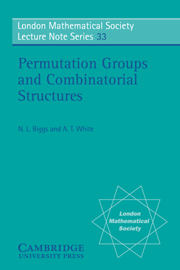Chapter 1 - Permutation Groups
Published online by Cambridge University Press: 04 February 2010
Summary
‘ … it will afford me much satisfaction if, by means of this book, I shall succeed in arousing interest among English mathematicians in a branch of pure mathematics which becomes the more fascinating the more it is studied.’
W. Burnside, in his preface to Theory of groups of finite order, 1897.Preliminary definitions
It is presumed that the reader will already be familiar with the contents of this section. He is advised to read it quickly, in order to accustom himself to the notation which will be used throughout the rest of the book.
If X is a finite set, a permutation of X is a one-to-one correspondence (bisection) α : X → X. Two such permutations α, β can be composed to give the permutation αβ : X → X, which we shall define by the rule αβ(x) = α(β(x)). That is, we shall write functions on the left, and compose in the order compatible with this convention. Under the operation of composition the set of all permutations of X forms a group Sym(X), the symmetric group on X. If X is the set {1, 2, …, n}, we write Sn for Sym(X), and we have |sn | = n! where we use | to denote cardinality.
If G is a subgroup of Sym(X), then we shall say that the pair (G, X) is a permutation group of degree | x |, and that G acts on X. More generally, we shall meet the situation where there is a homomorphism g ⇝ ĝ of a group G into Sym(X): this will be called a permutation representation of G.
- Type
- Chapter
- Information
- Permutation Groups and Combinatorial Structures , pp. 1 - 23Publisher: Cambridge University PressPrint publication year: 1979



